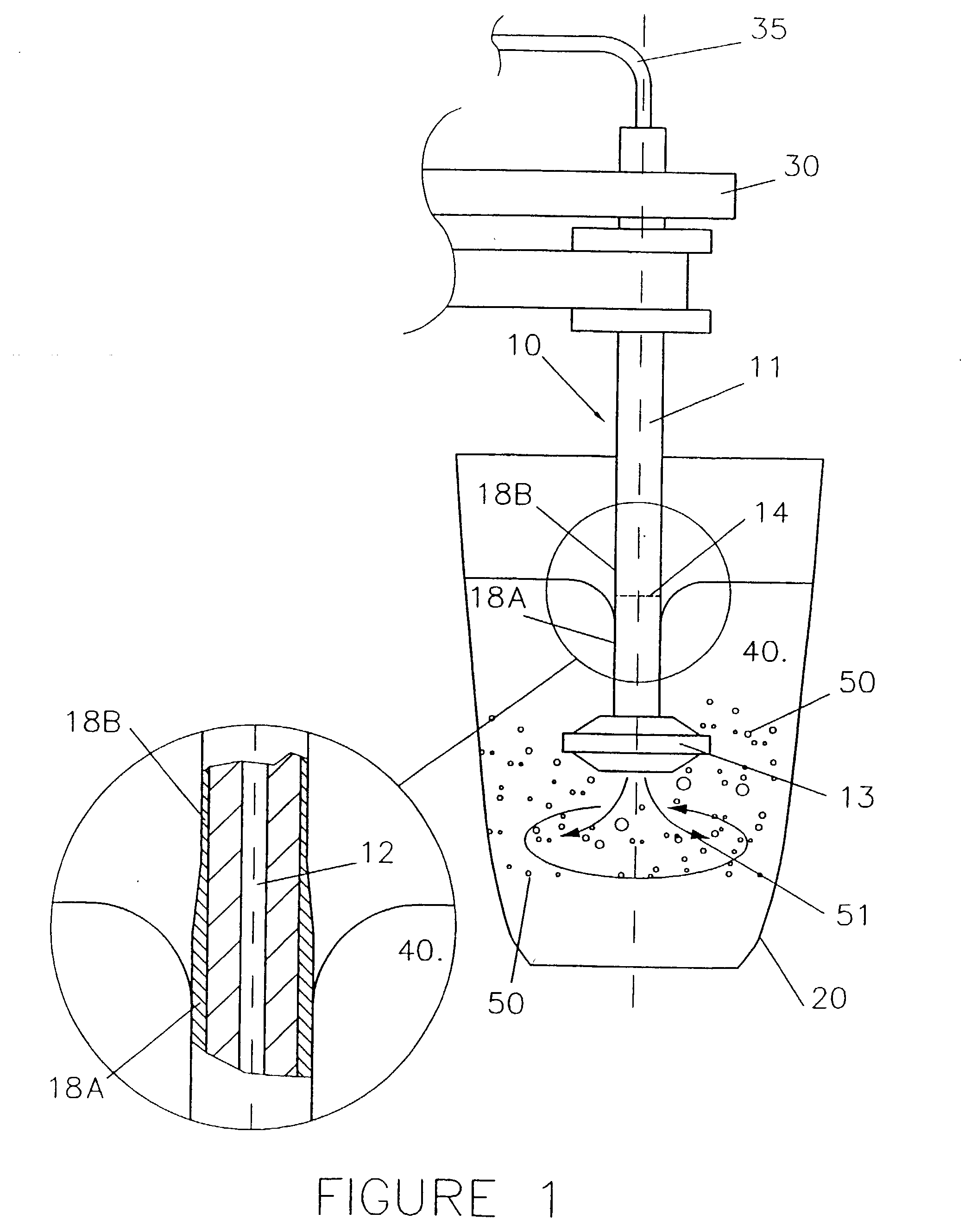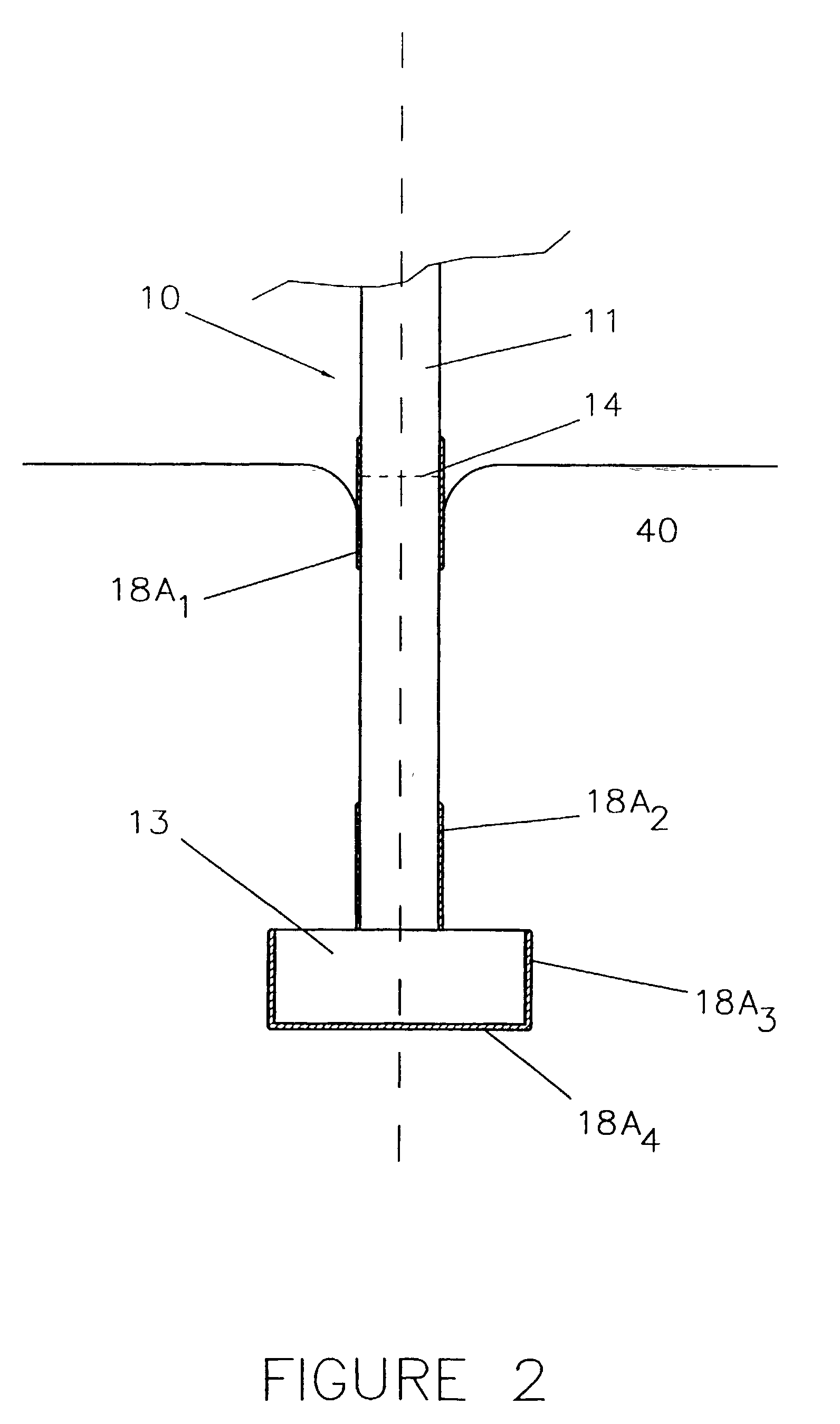Protection coating of wear-exposed components used for refining molten metal
a technology of protection coating and wear-exposed components, which is applied in the direction of furnace components, manufacturing converters, stirring devices, etc., can solve the problems of low porosity and/or low interconnectivity of graphite components, eroded stirrers or dispersers, and low corrosion resistance of stirrers
- Summary
- Abstract
- Description
- Claims
- Application Information
AI Technical Summary
Benefits of technology
Problems solved by technology
Method used
Image
Examples
example 3
[0116] Three rotary shafts of the same type as the shafts of comparative Example 1 were protected with a refractory coating according to the invention.
[0117] A slurry was prepared by mixing particulate TiB.sub.2, two grades of colloidal alumina and polyethylene glycol in the following proportions: 100 mg particulate TiB.sub.2 -325 mesh (99% of particles smaller than 45 micron and a mean particle size of 6 micron), 28 ml of a first grade of colloidal alumina (NYACOL.RTM. Al-20, a milky liquid with a colloidal particle size of about 40 to 60 nanometer) 24 ml of a second grade of colloidal alumina (CONDEA.RTM. 10 / 2 Sol, a clear, opalescent liquid with a colloidal particle size of about 10 to 30 nanometer) and 0.5 ml of polyethylene glycol (PEG 300).
[0118] Before applying the coating, the surface of each shaft was mechanically roughened by shot blasting to increase anchorage of the coating.
[0119] A coating was formed by brushing several layers of the above slurry onto the roughened surf...
example 4
[0121] As a modification of Example 3, the shafts are coated with a slurry of 100 g particulate TiB.sub.2 in 500 g of a cement consisting of approximately 57 weight % mullite (3Al.sub.2O.sub.3.2SiO.sub.2), 12 weight % silica (SiO.sub.2) and 31 weight % waterglass. The waterglass is an aqueous solution containing 33.4 weight % sodium silicate in the approximate formula Na.sub.2O.3.8Si0.sub.2.
[0122] Several layers of this slurry are successively applied onto the roughened surface of the shafts. Each applied layer is preferably allowed to dry at room temperature or with heating up to about 200.degree. C. before application of the next layer until a desired thickness, e.g. 0.4 mm, is obtained. The coating is then heat treated at about 950.degree. C. for consolidation to form a glassy protective coating.
[0123] The coated shaft can be used in molten aluminium as described in Examples 1 to 3 or for treating of other metals, such as magnesium, iron, steel or copper.
example 5
[0124] A further modification of Example 3 involves mixing 10 g particulate aluminium-iron alloy made of 60 weight % aluminium and 40 weight % iron to 90 g particulate TiB.sub.2 and suspending this particulate mixture in a carrier consisting of colloidal alumina and polyethylene glycol as in Example 3. Layers of this slurry containing particulate aluminium-iron alloy are applied onto a graphite shaft and dried thereon as in Example 3.
[0125] The coating is consolidated under an inert atmosphere by heat treatment at a temperature of 1200.degree. C. followed by cooling whereby the aluminium-iron alloy particles are fused into a continuous matrix in which TiB.sub.2 particles are embedded. Such a coated shaft can be used for treating molten metals up to a temperature of about 1100.degree. C., e.g. for treating molten magnesium, aluminium or copper.
PUM
| Property | Measurement | Unit |
|---|---|---|
| temperatures | aaaaa | aaaaa |
| thickness | aaaaa | aaaaa |
| thickness | aaaaa | aaaaa |
Abstract
Description
Claims
Application Information
 Login to View More
Login to View More - R&D
- Intellectual Property
- Life Sciences
- Materials
- Tech Scout
- Unparalleled Data Quality
- Higher Quality Content
- 60% Fewer Hallucinations
Browse by: Latest US Patents, China's latest patents, Technical Efficacy Thesaurus, Application Domain, Technology Topic, Popular Technical Reports.
© 2025 PatSnap. All rights reserved.Legal|Privacy policy|Modern Slavery Act Transparency Statement|Sitemap|About US| Contact US: help@patsnap.com



